Overview
In the world of photography, many struggle with the challenge of establishing a distinct identity. This can lead to feelings of frustration and uncertainty, especially when trying to connect with clients. The importance of creating a unique brand through various types of imagery—such as lifestyle, product, and personal branding photography—cannot be overstated.
By employing strategies like:
- Consistency
- Storytelling
- Thoughtful post-production techniques
photographers can enhance the emotional connection with their audience. These approaches not only improve the marketability of their work but also foster deeper relationships with clients. Remember, every photograph tells a story, and with the right branding practices, you can ensure that your story resonates beautifully with those who view it.
Introduction
In the competitive world of photography, establishing a strong brand identity is not just an option; it's a necessity that many photographers grapple with.
As visual content continues to flood the digital landscape, the challenge becomes even more pronounced. Photographers must find ways to differentiate themselves through effective branding strategies that truly resonate with their audience.
This article explores the multifaceted role of branding in photography, touching on various styles such as lifestyle, product, and corporate photography, while highlighting the essential elements that contribute to impactful imagery.
By understanding the intricacies of planning a brand photoshoot, leveraging storytelling techniques, and mastering post-production, photographers can elevate their work and foster deeper connections with clients.
Through insightful case studies, we will discuss how strategic branding photography can drive engagement and business success, ultimately transforming the way brands communicate their values and narratives.
Together, let’s navigate this journey of branding in photography, ensuring that your unique vision shines through.
Understanding the Role of Branding in Photography
At RNO1, we understand that many photographers struggle to create a distinct identity that truly resonates with their audience. This challenge goes beyond just having a logo or a catchy tagline; it’s about the style, tone, and emotional connection your images evoke. In a world overflowing with visual content, establishing a strong identity is not just beneficial—it’s essential for photographers who wish to stand out and connect meaningfully with their clients.
By embracing RNO1's design-driven solutions, photographers can enhance their marketability through Return On Design & Digital (RODD) strategies. Imagine consistently showcasing a unique style and narrative that mirrors your values and vision. This approach not only helps in crafting a cohesive portfolio but also attracts your ideal clients, fostering those long-term relationships that are so vital in your journey.
We believe that understanding the role of branding in photography is key to your success. As you navigate this path, remember that at RNO1, we are here to support you in creating a brand that reflects who you are and what you stand for. Together, we can turn your vision into a compelling identity that resonates with your audience.
Exploring Different Types of Branding Photography
Brand imagery presents a challenge for many companies striving to create a visual narrative that resonates. It encompasses various styles, each tailored to achieve specific goals. Let's explore some key types:
- Lifestyle Photography: This style captures authentic moments that resonate with your brand's values, fostering a personal connection with your audience. As we move into 2025, lifestyle imagery is becoming increasingly vital. Companies are eager to humanize their stories and connect with consumers on a deeper level.
- Product Photography: Essential for eCommerce businesses, this type focuses on showcasing products in a visually appealing manner, highlighting their features and benefits. With the rise of online shopping, effective product images can significantly sway purchasing decisions, making it a critical component of digital marketing strategies.
- Corporate Photography: This involves professional headshots and team photos that convey professionalism and trustworthiness. In an age where transparency and authenticity are paramount, high-quality corporate imagery is crucial for establishing credibility in the marketplace.
- Event Photography: Capturing company events helps construct a narrative surrounding community involvement and corporate culture. This form of imagery not only showcases your company's activities but also strengthens relationships with stakeholders and clients.
- Personal Branding Photography: Customized for individuals, this style highlights personality and authenticity, making it especially significant for freelancers and entrepreneurs looking to create their unique identity.
Understanding these different forms of branding visuals empowers photographers to select the most effective methods that align with their clients' branding objectives. As visual content continues to dominate marketing strategies—projected to account for 84% of communications—investing in professional imagery is essential for effective branding in photography. It enables brands to stand out in a crowded digital landscape. Statistics reveal that visual content marketing generates three times more leads than traditional outbound marketing, underscoring the importance of high-quality images in fostering engagement and conversions.
Moreover, seventy percent of marketers plan to enhance their use of original visual assets in campaigns, reflecting the growing trend of branding in photography. As Mallika Malhotra, a product photographer and mentor, wisely states, "To be regarded seriously as a business and to establish your identity as a leader in your field, your visuals must reflect that as well." This reinforces the necessity of professional imagery. A case study titled 'The Importance of Professional Images' illustrates how investing in visual representation can elevate a company's status, enhance storytelling, and cultivate deeper connections with the audience.
Key Elements of Effective Brand Photography
Effective brand photography often presents challenges that can feel overwhelming. Many tech startup founders struggle with establishing a cohesive visual identity that resonates with their audience. The problem lies in the need for consistency, authenticity, storytelling, attention to detail, and high-quality visuals, all of which are essential for building trust and credibility.
Imagine the frustration of putting in countless hours to create a brand, only to have your visuals fail to communicate your essence. This disconnect can lead to missed opportunities and a lack of emotional connection with potential clients. It’s crucial to understand that each photograph serves as a powerful tool in conveying your company’s narrative, fostering genuine interactions that can truly resonate.
By focusing on key elements such as:
- Consistency in style and color
- Authenticity in capturing real moments
- Storytelling that aligns with your brand’s mission
You can create impactful visuals. Attention to detail—thoughtfully choosing props and backgrounds—can enhance your message significantly. Additionally, investing in high-quality photography is vital for establishing credibility and trust.
As you concentrate on these components, remember that you’re not alone in this journey. Many have faced similar hurdles, and by embracing these strategies, you can strengthen your brand’s identity through photography. Together, we can produce powerful visuals that clearly convey your organization’s values, creating an emotional connection that lasts.
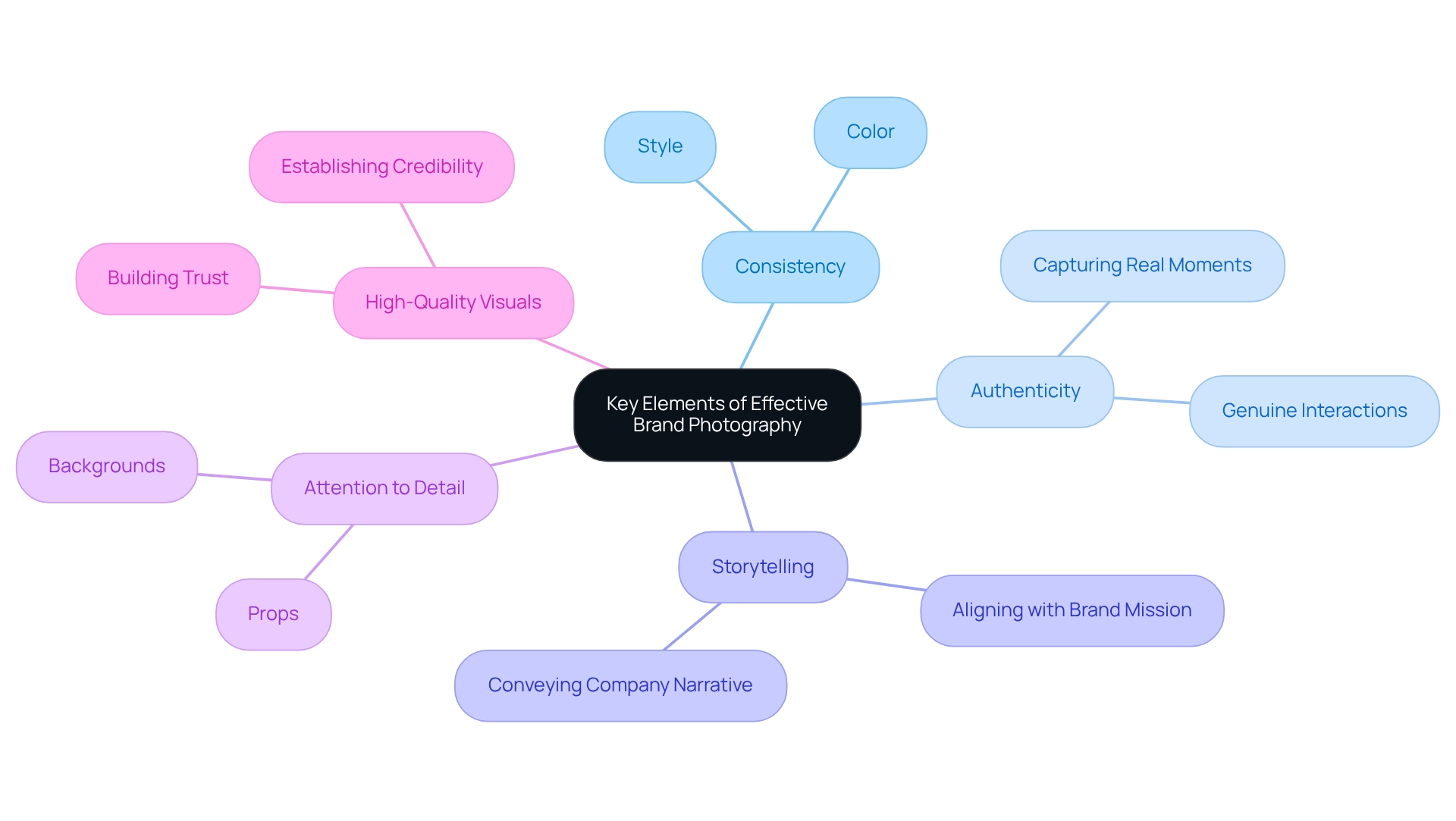
Planning Your Brand Photoshoot: Essential Tips
Organizing a promotional photoshoot can feel overwhelming, especially when you want the final images to truly reflect your identity. It’s essential to approach this strategically and with care. Here are some key guidelines to help you navigate this process with confidence:
- Define Your Goals: Begin by outlining what you hope to achieve with your photoshoot. Reflect on the message you want to communicate and how these visuals will be shared across various platforms. This clarity will guide your creative decisions and ensure your vision is realized.
- Create a Mood Board: Consider crafting a mood board as a visual representation of your desired aesthetic and style. Collect images, color palettes, and textures that resonate with your identity. Research shows that mood boards can significantly enhance the impact of promotional photoshoots, aligning the creative vision among your team members and fostering a collaborative spirit.
- Choose the Right Location: The setting of your photoshoot is pivotal in telling your story. Select a location that not only complements your identity but also enriches the narrative you wish to convey. For example, 28% of marketers utilize location data to create more compelling imagery, particularly in sectors like automotive marketing.
- Prepare a Shot List: To ensure a smooth and efficient shoot, consider preparing a detailed shot list that specifies the images you want to capture. This thoughtful planning helps cover all necessary angles and elements, minimizing the risk of missed opportunities and reinforcing your commitment to quality.
- Coordinate Outfits and Props: Thoughtfully plan your wardrobe choices and props to align with your visual identity. Consistency in these elements strengthens your message and enhances the overall aesthetic of the shoot, making your visuals more impactful.
- Hire Experts: Collaborating with a stylist or a professional photographer who specializes in brand identity can elevate the quality of your images. Their expertise can help translate your vision into compelling visuals that resonate with your audience. It’s also important to remember that high-quality imagery can be achieved through DIY efforts, making it accessible for various budgets.
By embracing these guidelines, you can ensure a smooth and successful branding photoshoot, ultimately resulting in high-quality imagery that captures the essence of your identity and engages consumers effectively. Remember, 78% of customers desire more product images when shopping online, and 27% of consumers find personalization essential for fostering loyalty to a company. Tailoring experiences can significantly enhance consumer connections and loyalty, as illustrated in the case study "The Impact of Personalization on Branding." Let’s work together to create visuals that truly reflect who you are.
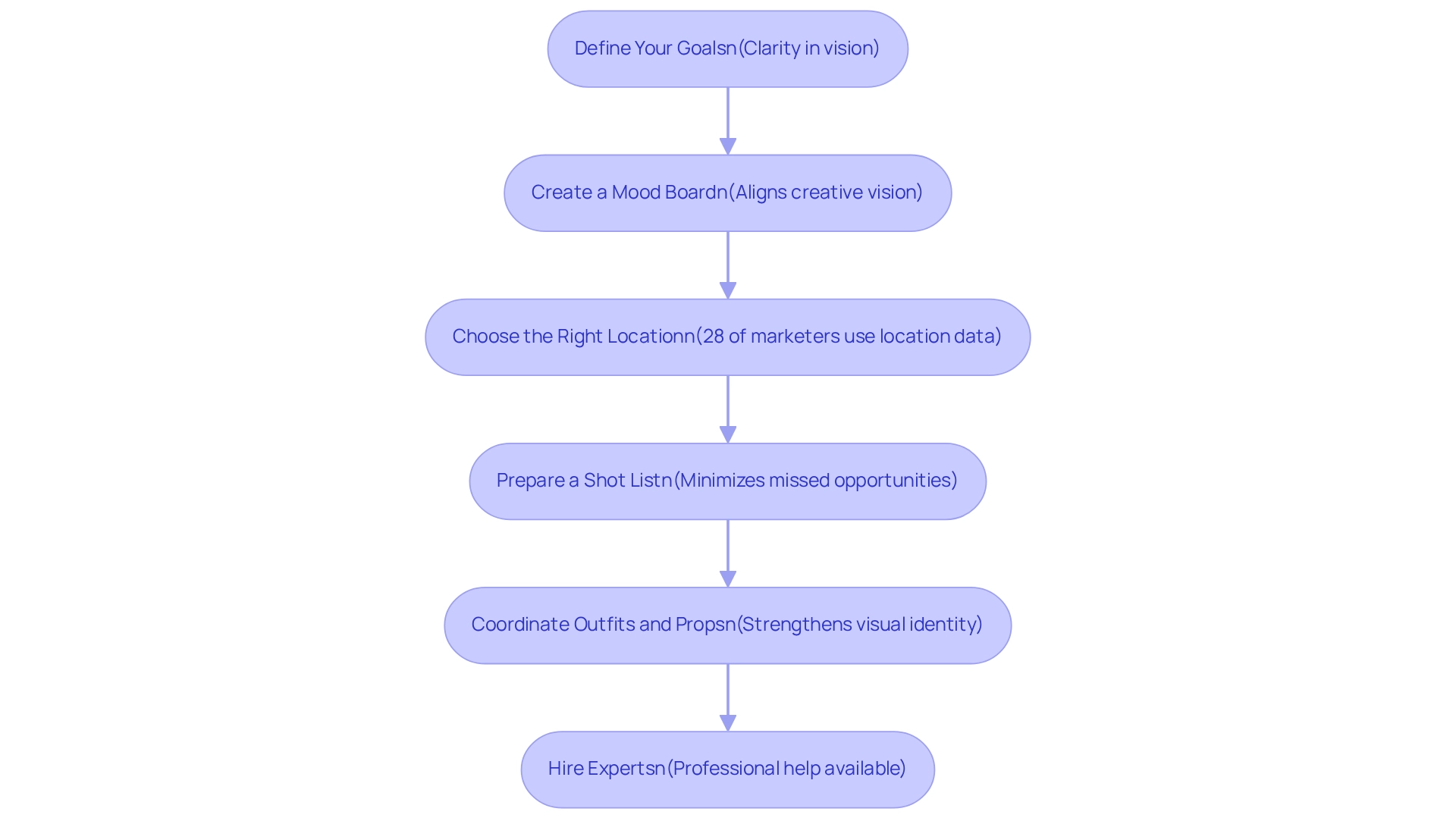
The Power of Storytelling in Brand Photography
Storytelling in product photography is about creating a narrative that resonates with the audience, especially in the context of RNO1's strategic rebranding of Founder's Haven. This initiative aims to empower modern founders for digital success. However, many founders struggle to convey their unique stories effectively. This challenge can leave their brand feeling disconnected from potential customers.
To address this, consider the following approaches:
- Visual Narratives: Each picture should contribute to a larger story. This could reflect the organization's mission, values, or the innovative strategies that define its identity. For instance, showcasing a contemporary founder in action can illustrate the organization's commitment to innovation and entrepreneurship, which is essential for effective branding in photography.
- Emotional Connection: Capturing authentic moments and feelings helps humanize the entity. This makes it more relatable to the audience, reflecting the transformative journey of modern founders. Sharing a case study that showcases a founder's success story can serve as a compelling visual narrative.
- Consistency in Messaging: It’s vital to ensure that the tale conveyed through visuals aligns with the organization's overall messaging and values. This reinforces its identity and the performance marketing strategies that support it. Highlighting RNO1's approach to maintaining brand consistency across various platforms can serve as a best practice.
- Diverse Perspectives: Incorporating various angles and subjects provides a well-rounded view of the brand's story. This showcases the dynamic nature of the modern entrepreneurial landscape. Visuals from various events or initiatives led by RNO1 can illustrate its influence on the community.
By utilizing storytelling, photographers can create captivating visuals that not only highlight products or services but also engage and inspire their audience. This emphasizes the role of branding in photography within RNO1's creative marketing efforts. Specific case studies and examples of RNO1's identity and performance marketing strategies can further enrich the narrative, illustrating how Founder's Haven has been successfully rebranded to optimize the modern founder experience.
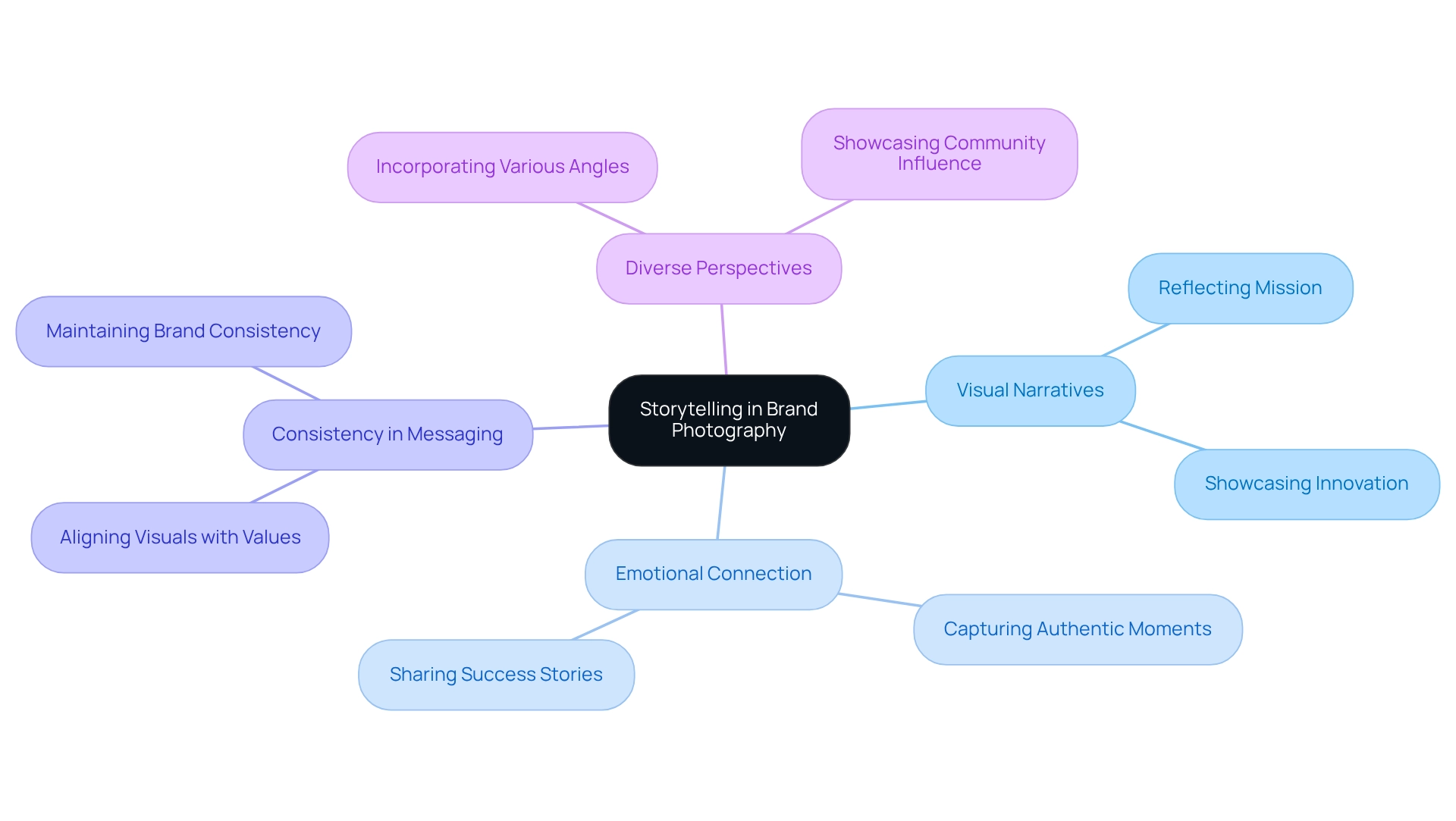
Post-Production Techniques for Branding Photography
In the world of photography, post-production can often feel like an overwhelming task, yet it holds the key to transforming your visuals into powerful branding tools. Many photographers struggle with ensuring that their images resonate with their audience and effectively communicate their brand's essence. This challenge can lead to frustration, as the final visuals may not reflect the vibrant identity they wish to portray.
Imagine the difference it could make if you could confidently enhance your images through thoughtful editing techniques. Color correction is one such technique, allowing you to adjust colors so they appear vibrant and true to life, aligning beautifully with your brand's palette. Retouching plays a vital role as well, helping to remove imperfections and distractions, resulting in a polished look that still feels authentic.
Cropping and framing are essential for fine-tuning composition, directing attention to your subject, and enhancing visual impact. Consistency across visuals is equally important; employing similar editing techniques fosters a unified appearance that strengthens identity recognition. And let’s not forget the power of adding elements—graphics or text overlays can enrich your visuals, conveying additional information about your brand in a meaningful way.
By mastering these post-production techniques, you can elevate your promotional images, creating visuals that not only capture attention but also leave a lasting impression. Remember, you’re not alone in this journey. Embrace these strategies, and watch as your branding in photography flourishes, nurturing connections with your audience and fostering a sense of community around your brand.
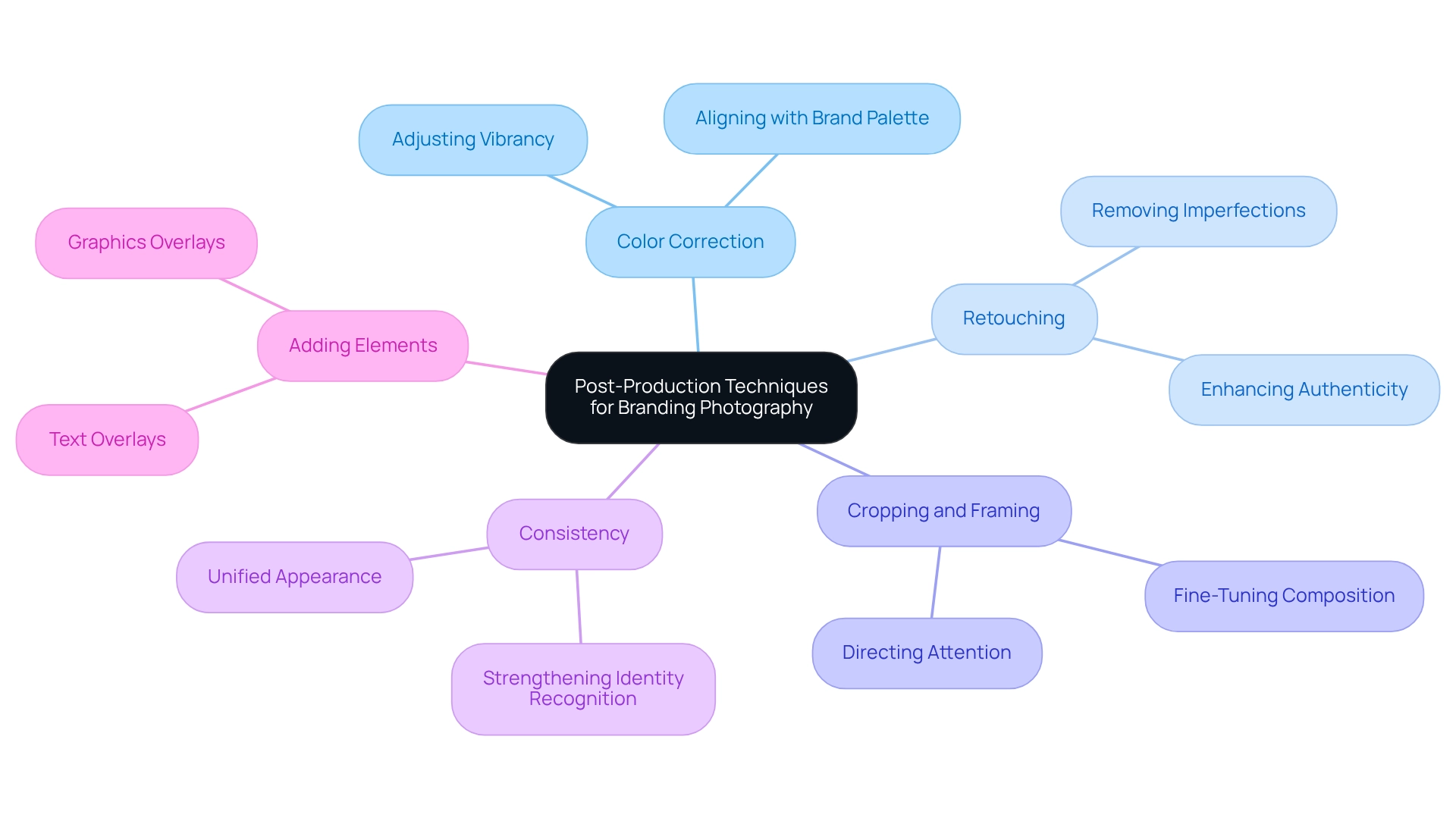
Common Pitfalls in Branding Photography and How to Avoid Them
Avoiding common pitfalls in branding within photography is essential for realizing your creative vision. Many photographers encounter challenges that can hinder their success, and it's important to recognize these obstacles.
One significant issue is the lack of planning. When a shot list or mood board isn't prepared, opportunities can slip away, leaving shoots feeling chaotic and unstructured. This disorganization can be frustrating, especially when you have a clear vision in mind.
Another common mistake is inconsistent style. When different styles or editing methods are employed, it can confuse your audience, making it harder for them to connect with your brand. Consistency is key in building recognition and trust.
Additionally, ignoring the audience can be detrimental. If the preferences of your target audience aren't considered, the visuals you create may not resonate, leading to missed connections. Remember, your audience's tastes and expectations matter.
Furthermore, over-editing can distort the true essence of your brand. Excessive retouching may create an unrealistic representation, which can ultimately lead to distrust among your viewers. Authenticity is crucial in fostering genuine relationships.
Lastly, neglecting storytelling can render your images forgettable. While aesthetics are important, a narrative thread weaves meaning into your work, making it memorable and impactful.
By acknowledging these pitfalls, you can take proactive steps in your branding efforts. Embrace a thoughtful approach to your photography, ensuring that your promotional images are not only visually appealing but also aligned with your objectives and resonate deeply with your audience. Together, we can navigate these challenges and create a branding strategy that truly reflects your vision.

Case Studies: Successful Branding Through Photography
Examining successful case studies can provide valuable insights into effective branding visuals, particularly in the context of RNO1's strategic rebranding of Founder's Haven to empower modern founders. Many founders face the challenge of standing out in a crowded market, and understanding how others have navigated this can be incredibly enlightening. Notable examples include:
- Tech Startup A: This startup utilized lifestyle imagery to showcase their product in real-world scenarios, enhancing relatability and engagement. The campaign led to a 30% rise in user sign-ups, illustrating how impactful visuals can enhance user acquisition.
- E-commerce Brand B: They concentrated on high-quality product images that showcased unique features, resulting in a 50% boost in conversion rates. This case demonstrates the significance of highlighting product features to enhance sales potential.
- Personal Brand C: By employing narrative methods in their personal image creation, they formed a strong emotional bond with their audience, leading to a notable increase in social media following. This emphasizes how narrative-driven visuals can improve customer loyalty.
These case studies illustrate the impact of strategic photography and branding in achieving business objectives and engaging with audiences. They showcase RNO1's performance marketing expertise in hyper-scaling eCommerce, including their collaboration with Cirkul. The rebirth of the Founder's Haven brand is a testament to RNO1's commitment to empowering modern founders through innovative branding strategies. As you embark on your journey, remember that strategic visuals can be a powerful ally in connecting with your audience and achieving your goals.
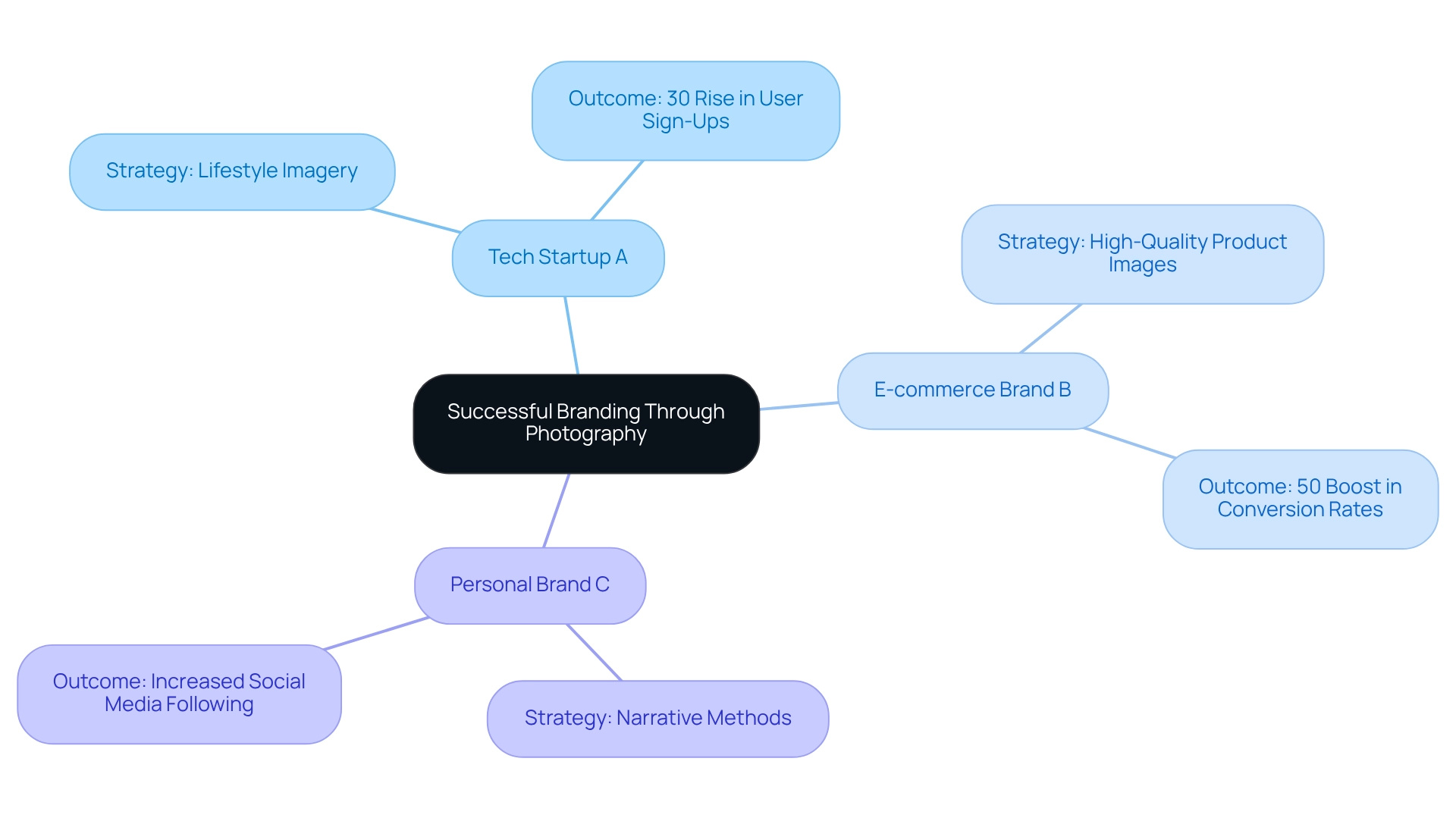
Conclusion
In today's crowded digital landscape, establishing a powerful brand identity in photography can feel overwhelming. Many photographers struggle to stand out, and this challenge can create a sense of frustration. However, by understanding the diverse styles of branding photography—whether it be lifestyle, product, corporate, or personal branding—photographers can align their work with their clients' objectives, helping them to shine in their respective markets. Each type serves a unique purpose, emphasizing the importance of tailored imagery that truly resonates with target audiences.
Key elements such as consistency, authenticity, and storytelling are vital for creating impactful visuals that communicate a brand's values. When planning a brand photoshoot, having a clear strategy is essential. This ensures that every image captures the essence of the brand, engaging consumers in a meaningful way. Moreover, mastering post-production techniques can enhance the final output, polishing the imagery to align seamlessly with the brand's visual identity.
It’s important to be aware of common pitfalls, like lack of planning and neglecting audience preferences, which can hinder achieving desired outcomes. Successful case studies remind us how effective branding photography can drive engagement, increase conversion rates, and foster deeper connections with audiences. Ultimately, photographers who embrace strategic branding techniques not only elevate their craft but also empower brands to communicate their narratives more compellingly. By transforming visual storytelling into a powerful tool for business success, they can help brands connect with their audiences in profound and lasting ways.
Frequently Asked Questions
Why is having a distinct identity important for photographers?
A distinct identity is essential for photographers to stand out in a crowded market and connect meaningfully with their clients. It goes beyond just having a logo or tagline; it involves the style, tone, and emotional connection evoked by their images.
How can RNO1 assist photographers in enhancing their identity?
RNO1 offers design-driven solutions and Return On Design & Digital (RODD) strategies that help photographers showcase a unique style and narrative, aligning with their values and vision. This approach aids in creating a cohesive portfolio and attracting ideal clients.
What is the role of branding in photography according to RNO1?
Branding in photography is key to success, as it helps photographers create a brand that reflects who they are and what they stand for. RNO1 supports photographers in developing a compelling identity that resonates with their audience.
What are the different types of brand imagery mentioned?
The key types of brand imagery include: Lifestyle Photography, Product Photography, Corporate Photography, Event Photography, and Personal Branding Photography.
Why is professional imagery important for branding?
Professional imagery is crucial for effective branding as it helps brands stand out in a digital landscape. High-quality images foster engagement and conversions, with visual content marketing generating three times more leads than traditional methods.
What trends are emerging in visual content marketing?
Seventy percent of marketers plan to enhance their use of original visual assets in campaigns, reflecting a growing trend towards branding in photography. This indicates an increasing recognition of the importance of professional imagery in establishing business identity.
How can effective branding through photography impact a company's status?
Investing in professional images can elevate a company's status, enhance storytelling, and cultivate deeper connections with the audience, ultimately leading to greater success in their marketing efforts.




